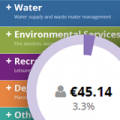
Local Authority Rent Arrears In Dublin
23 Nov 2016Key Point
Approximately €32 million in local authority rent arrears was outstanding at the end of 2015 in the four Dublin local authorities. Of the close to 24,000 tenancies in Dublin City Council, 6,300 or 26% are in arrears to the value of 12 weeks rent or more.
Introduction
Close to €129m will be collected in housing rents in the Dublin local authorities in 2016. Dublin City will collect circa €75m followed by South Dublin (€22.4m), Fingal (€18.5m) and Dún Laoghaire Rathdown (€14.4m). The average monthly rent of €254 in Dublin City Council is circa one-fifth of the average market rent in Dublin city, or one quarter of the national average rent1.
Table 1 shows the arrears across the four Dublin councils between 2013 and 20152.
Table 1 – Rent Arrears in the four Dublin Local Authorities, 2013 – 2015
Dublin City Council (DCC) has the highest nominal arrears at €18.7m. Arrears are falling in DCC with a decrease of 8 per cent (€1.6m) between 2013 and 2015 from €20.3m to €18.7m. In contrast, arrears in South Dublin have increased by 8.7 per cent, and 5.7 per cent in Fingal. Overall arrears in the Dublin councils have fallen by 3 per cent, by just under €1m. Dublin City Council was the only Dublin council which saw arrears contract in 2015 over 2014 by 5 per cent, while they increased in Dún Laoghaire (9.6%), Fingal (11.5%) and South Dublin (0.7%).
Collection Rates
An average of 81% of rent has been collected over the past three years in the four Dublin councils. Table 2 shows the collection rates in nominal and percentage terms between 2013 and 2015.
Table 2 – Collection Rates, 2013 – 2015
Fingal County Council has the highest collection rate amongst the four councils at 90%. Taken as a percentage of rent collected in 2015, arrears are highest in South Dublin at 35.7%, followed by Dún Laoghaire Rathdown (26.6%), Dublin City (25.7%), and Fingal (11%).
Dublin City Council
Table 3 shows figures related to Q2 2016 for Dublin City Council’s rental sector.
Table 3 – Dublin City Council Rental Sector, Q2 2016 data
Of the close to 24,000 tenancies in DCC, 6,300 or 26% are in arrears to the value of 12 weeks rent or more. The average length of time to pay off arrears varies, depending on individual financial circumstances. Repayment amounts will vary in line with income changes and family composition.
Addressing Rent Arrears in Dublin City Council
To facilitate payment, tenants can pay their rent using a ‘rent card’ at the post office (through the Household Budget Scheme), certain retail outlets, or at the Council offices. People may also choose to pay by direct debit or online.
More than 90 per cent of tenants in arrears in Dublin City Council are on rescheduling arrangements to pay off their arrears. The average weekly value of hardship supports for those in particular financial difficulties is €361.
Dublin City Council’s collection of arrears is better understood when one considers the collection rate as a percentage of accrued rent in a particular year (excluding overruns). Between 2013 and 2015, the city council collected over 100 per cent of its accrued rent. It is the Council’s policy to apply retrospective debits to accounts in the case of under-declaration of household income and occupants. This accounts, in part, for the average arrears of €3,440 among tenants and the total arrears of €19.6m in 2015.
The highest proportion of current arrears was incurred in 2009 following retrospective assessments of income/occupants which brought previously undeclared income to attention. An early intervention system is now operational in the Council which warns tenants whose accounts are in arrears. Tenants receive a quarterly statement to inform them of their rental balance and any outstanding arrears.
Differential Rents Scheme – How to determine rent levels?
The Programme for a Partnership Government 2016 commits to a review of
“the disparate systems of differential rents for social housing across local authorities to ensure that housing supports, including the HAP3, are fair and sustainable, prioritise those on the lowest incomes and avoid creating social welfare traps that stop people returning to work or to the private housing market”.
A National Differential Rents Framework
Section 31 of the Housing (Miscellaneous Provisions) Act 2009 allows the Minister to make regulations in respect of a rent scheme. These can include the sources of household income that may be assessed for the purpose of determining rent levels. The framework aims to create a more harmonised approach to the operation of rent schemes across all 31 local authorities. One such measure would be to determine a common set of income disregards when calculating assessable income for rental contributions. The review is due to completed by quarter 2, 20174. A new national differential rent scheme framework is provided for under the Housing (Miscellaneous Provisions) Act 2009, but has been postponed regularly, and was last due to be introduced in July 2015.
The proposed Base Rates and Bandings, as suggested in July 2014, are shown below. An additional charge would apply where net household income (after tax and PRSI) exceeds a reckonable income threshold of €14,000 per year for the first adult, plus €10,000 for each further adult and €1,500 for each child/full-time student under 23.
Table 4 – Base Rents and Bands
Conclusion
The Local Government Efficiency Review Group (July, 2010) recommended that social housing rents should be deducted directly from social welfare payments “to reduce overheads associated with revenue collection in this area and to substantially reduce arrears, as well as to streamline processes for local authority tenants and avoid accumulation of arrears”5. The Group also recommended that this should be a condition of new tenancies. Section 53 of the Housing (Miscellaneous Provisions) Act 2014 provides for the deduction of local authority rents and rent arrears from social welfare payments. However, this section of the Act has not yet commenced.
_______________________
Notes:
1 Daft.ie rental report for Q3 2016
2 Across the 31 local authorities in 2014 there were rental and annuity arrears of €65.5m. The average rate of collection was 84%. Rent arrears accounted for 19% of the accrued rent of €351m in 2014.
3 Housing Assistance Payment (HAP) requires the recipient of the payment to pay a rent contribution to the local authority in respect of their rent. The contribution is calculated under the differential rents scheme (i.e. based on income and ability to pay). The local authority pays the rent on behalf of the HAP recipient directly to the landlord. HAP allows recipients to take up full-time employment and retain their housing support.
4 Simon Coveney, Parliamentary Questions – written answers (11 October, 2016)
5 Report of the Independent Local Government Efficiency Review Group (July, 2010)









